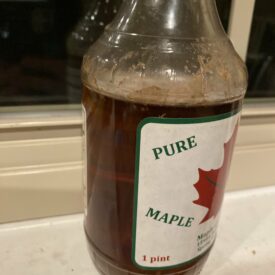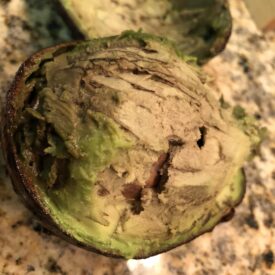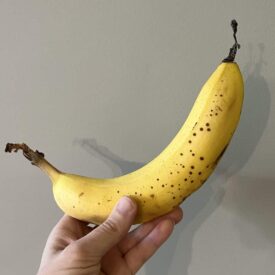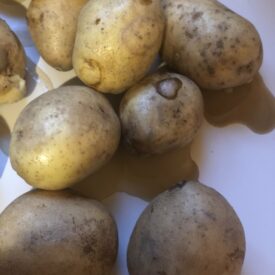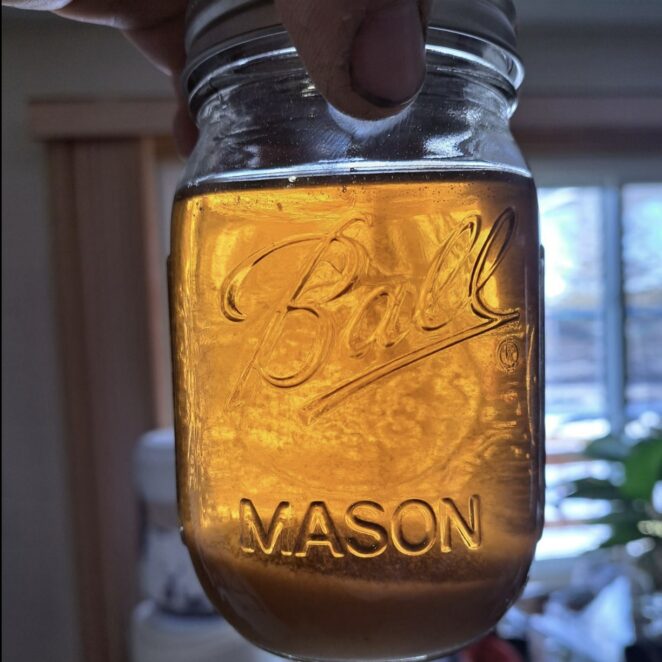
What you see: Some sediment or cloudiness at the bottom of your jar of maple syrup.
What it is: Sugar sand! Also called “niter.” These are solids that fall out of maple sap as it thickens during syrup making. The solids are supposed to be filtered out, but sometimes they literally slip through the cracks. And, sometimes another kind of sediment, grit used to aid in filtering, can end up at the bottom of syrup bottles.
Eat or toss: The syrup above the sugar sand is fine to eat, though if the sugar sand has been there for a while, the syrup itself might have absorbed some off flavors. The presence of sugar sand does not mean your syrup is unsafe, but you don’t want to eat the sandy stuff as it will be gritty.
Why does cloudiness or sediment sometimes appear at the bottom of jars of maple syrup?
Something cloudy or sandy at the base of your bottle of maple syrup may be off putting, but it’s probably harmless. It’s likely “sugar sand,” which is made up of some innocuous byproducts of boiling maple sap into syrup. This grit is usually filtered out before bottling. Ironically, another potential source of sediment at the bottom of a maple syrup jug is a filtering aid that helps remove sugar sand. We’ll get into more detail below.
In any event, the cloudy or sandy-looking stuff might add some unwanted grittiness to your maple syrup, but it won’t make it unsafe. Once the sediment settles on the bottom, you can decant the portion of the syrup that’s clear into a new container and discard the sandy or cloudy stuff.
What causes cloudiness at the bottom of a maple syrup bottle?
Maple sap flows thin and clear when it’s tapped from the tree. It’s then boiled, which thickens and browns it, creating syrup. According to the Michigan State University Extension, it takes 43 gallons of maple sap to make one gallon of maple syrup. These days many large producers use reverse osmosis to reduce the water content before boiling, which helps reduce the energy needed for syrup production.
During boiling, minerals that were suspended or dissolved in the sap precipitate out: as the water evaporates, there’s less water for those minerals to be dissolved in so they eventually sink. Sort of like how if you add too much lemonade mix to a glass of water, some will never dissolve and will settle at the bottom.
Syrup producers know no one wants gritty pancakes so they filter their syrup before bottling. But if the filter isn’t fine enough or the syrup maker miscalculates, some sugar sand can make it through and eventually settle at the bottom of your jar.
“It’s common to have sugar sand in small operations that use cloth filters with a larger micron size compared to larger operations that usually have filter paper, filter aid, and a vacuum pump to move the syrup through,” Catherine Belisle, a research support specialist at the Cornell Maple Program, wrote in an email.
Maple syrup must be filtered to earn a Grade A designation. People who produce syrup at home or for their own use might not mind it or might be able to simply use a coffee filter for a minimal amount of filtering.
What exactly is in sugar sand?
The sugar sand at the bottom of your maple jug started out as minerals dissolved in water that the maple tree’s roots drank up from the earth. As soil mineral content can vary, Les Ober, a Geauga County extension agent for Ohio State University, notes on the university’s maple website that trees vary in the amount of sugar sand, also known as niter, that their sap produces.
Calcium and malic acid, an acid found in fruits like apples, are common in sugar sand, according to a USDA report published in 1963. Together the two can create calcium malate, which the USDA notes is one of the least soluble salts found in maple syrup. The 1963 report also found abundant quantities of a material they couldn’t quite identify but believed was probably silica, which is also found in beach sand and quartz crystals.
Some sugar sand is easy to remove, while other times it can be pasty and hard to get out of the syrup.
What else could cause sediment at the bottom of a bottle of maple syrup?
Ironically, one method of removing sugar sand can also result in additional grit at the bottom of a bottle of syrup. The sediment at the bottom of your jar could be “diatomaceous earth,” a type of stone that’s pulverized and mixed into the syrup to help with filtering. Like sugar sand, it’s harmless. Syrup makers only use food-grade diatomaceous earth. So it’s not toxic, but it would certainly feel unpleasant in your mouth!
Interestingly, diatomaceous earth, which resembles a fine white sand, is made from the fossilized remains of diatoms, tiny, water-dwelling creatures. They have a variety of complex shapes, which make them great for filtering.
Typically only large syrup operations use diatomaceous earth because it requires specialized equipment. They mix the white powder directly into the syrup, then pump it through pressurized filters. This video demonstrates how it all works and also explains the gravity filter system that smaller producers typically use:
Could the sediment at the bottom of a bottle of maple syrup be mold?
That’s unlikely. Mold needs oxygen to grow, which is why it typically forms on the surface of syrup. See what that looks like in this post about moldy syrup.
Is the sediment in syrup called “sugar sand” or “niter”?
I’ve seen both “sugar sand” and “niter,” as well as “loose scale,” used to refer to the sediment that sometimes sneaks into bottles. The substance is also sometimes called “scale” as it clings to equipment the way that minerals might leave traces behind on a pot you use to boil water.
Thank you to Adam Greely, a hobbyist syrup maker, for sharing the image at the top of this post. After finding too much sugar sand in his syrup, he revisited his filtering process, adding more pre-filtering steps. A year after this photo was taken, he reports that he no longer has issues with too much sugar sand.
SOURCES:
- Catherine Belisle, PhD. Research Support Specialist. Cornell Maple Program. Cornell University, Dept. of Natural Resources and the Environment
- Maple Production for the Beginner Part 7: Regulations. Steve Childs, Cornell University Maple Specialist. March 14, 2018
- Filtering Maple Syrup. UVM Proctor Maple Research Center. Aug 17, 2020
- Fundamentals of Filtering Maple Syrup. Best practices for filtering pure maple syrup. University of Vermont Extension. Nov. 23, 2016.
- Tips on Managing Sugar Sand. Les Ober, Geauga County. Ohio State University Extension March 25, 2015.
- 168.140 Maple sirup. Food and Drugs. Food For Human Consumption. Sweeteners and Table Sirups. Code of Federal Regulations.
- The Chemical Composition of Maple Sugar Sand. D. Robert Davis, James F. Gallander, John Hacskaylo, W. A. Gould, C. O. Willits. Journal of Food Science. March 1963. (A report of work done under contract with the U. S. Department of Agriculture.)
- Why are maple trees tapped to make maple syrup? Russell Kidd, Michigan State University Extension. March 14, 2013
- Maple Syrup Grades & Standards. Agricultural Marketing Service. United States Department of Agriculture.
- Various articles from Britannica on topics including: sap (plant physiology), aromatic acids, sands, diatoms, and diatomaceous earth.
- MaxFlux Diatomaceous Earth. Dutch Filtration.
- Fundamentals of Filtering: Best practices for filtering pure maple syrup. University of Vermont Extension. 2016.
- Chemical Composition of Scale in Maple Syrup Evaporators Mark Isselhardt, Abby van den Berg and Timothy Perkins University of Vermont, Proctor Maple Research Center.
- United States Standards for Grades of Maple Syrup. Agricultural Marketing Service. United States Department of Agriculture. Effective March 2, 2015

